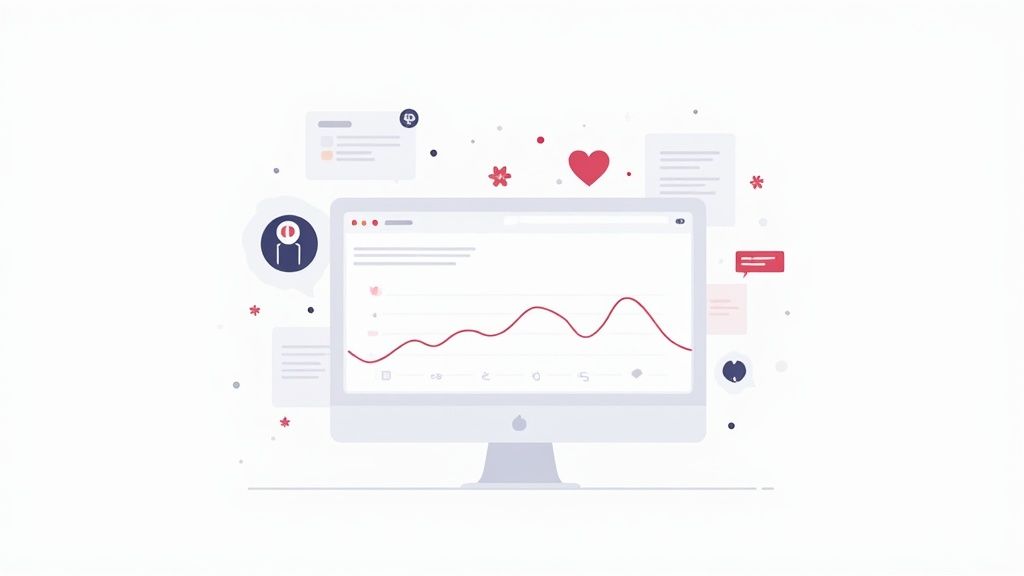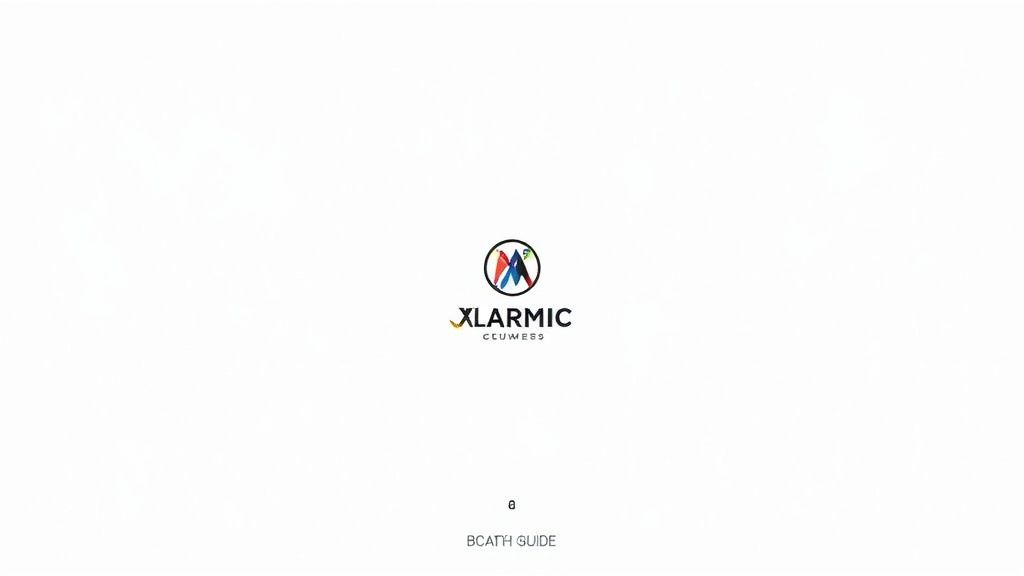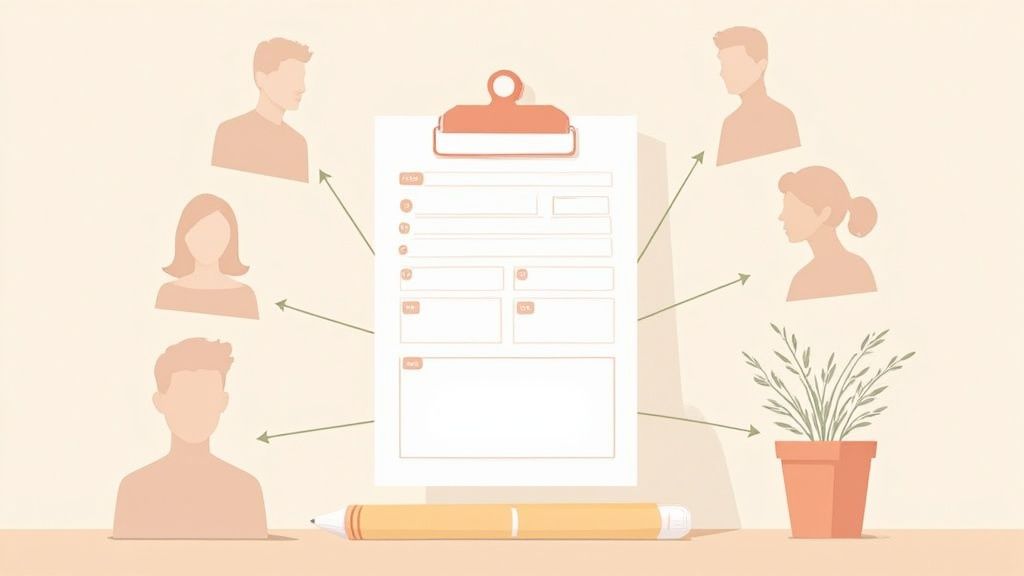Why Your Personal Branding Blog Is Career Currency
In today’s competitive job market, a personal brand is essential. Think of your personal branding blog as career currency. It’s a central hub showcasing your expertise, your experience, and your unique perspective. This helps you stand out and attract valuable opportunities. It's not just about being visible; it's about building a reputation as a thought leader.
Beyond Visibility: The Tangible Benefits
A personal branding blog offers tangible benefits that can significantly boost your career. Many professionals have used their blogs to secure speaking engagements, land book deals, and even advance into leadership roles. This recognition positions you as a go-to resource in your industry. A personal blog also provides a stable platform to control your narrative, independent of social media algorithms.
Owning Your Narrative: Stability and Appreciation
Imagine building your professional presence solely on social media. Algorithm changes, platform updates, or even account suspensions could erase years of work. Owning your personal branding blog gives you complete control. Your content, your voice, and your brand remain yours. This creates a valuable asset that appreciates over time. The longer you cultivate your blog, the more authority and influence you build. Personal branding has become incredibly influential in business and career development. For example, 74% of Americans are more likely to trust someone with an established personal brand. This trust can significantly enhance professional opportunities and business success. Find more detailed statistics here: Personal Branding Statistics
The Psychological Advantage: Becoming a Recognized Resource
Having a personal branding blog doesn't just change how others see you; it changes how you see yourself. When you consistently share your knowledge and insights, you begin to see yourself as a valuable resource. This increased confidence changes how you present yourself in interviews, negotiate salaries, and pursue new opportunities. It's the difference between hoping to be noticed and knowing you deserve a seat at the table.

Crafting Your Distinctive Personal Brand Identity
Standing out online takes more than just skills. It requires knowing what makes your perspective special. Building a thriving personal branding blog begins with crafting a distinctive identity. This means identifying your strengths, passions, and how they meet market needs. Your personal brand is like your professional fingerprint—it's what makes you unique.
Unveiling Your Authentic Self
Discovering your authentic brand identity is a journey of self-exploration. It’s about diving deep into your personal and professional experiences to find where your passions, skills, and market opportunities intersect. This is where self-assessment frameworks can be incredibly helpful. These frameworks offer structured exercises to help you tell your origin story, define your core values, and pinpoint your unique approach.
Ask yourself: What comes naturally to you? What topics ignite your enthusiasm? What problems can you solve that others can't? These questions help you build the foundation of your personal brand. This foundation will guide your future content and interactions.
Understanding Your Audience
A personal branding blog isn't about broadcasting to an audience; it's about connecting with them. Audience research is crucial. It helps you identify market gaps your perspective can fill and tailor your message to resonate with specific groups.
Developing brand voice guidelines ensures consistency across your content. This builds trust and reinforces your brand identity. Think of a musician with a distinctive sound; their consistent style makes them instantly recognizable. Your brand voice does the same for you in the digital space.
Defining Your Unique Value Proposition
Successful personal brands stand out with a clear value proposition. This is the core message that communicates the unique value you offer. It answers the question: “Why should someone follow your blog?”
Your value proposition shapes your messaging architecture, ensuring your content consistently reinforces your key message. For instance, Henri Den built his personal brand around his late-career pivot to content creation. His 27 years of experience, combined with his use of AI, positions him uniquely in the personal branding world. This blend of experience and a future-focused mindset forms the bedrock of his distinct personal brand identity.

Designing a Sustainable Content Ecosystem
Creating compelling content for your personal branding blog isn't about churning out massive amounts of work; it's about building a sustainable content ecosystem. This means developing a system that gracefully balances quality with consistency, allowing your brand to grow organically. This is how successful thought leaders establish their online presence.
Identifying Your Content Pillars
Start by identifying your content pillars. These are the core themes that will define your blog and attract your target audience. Think of these pillars as the foundation of your personal brand. For Henri Den, these include personal branding, finding purpose, using AI as a solopreneur, and mindset & growth. Focusing on these core areas provides structure and ensures your content remains relevant to your brand’s message.
Keyword Research for Personal Brand Positioning
Once you’ve established your content pillars, conduct keyword research specific to personal brand positioning. This helps you understand what your target audience is searching for and ensures your content gets discovered. Tools like Semrush and Ahrefs can help you identify relevant keywords with high search volume. For example, if one of your pillars is “using AI as a solopreneur,” you might target keywords like “AI tools for freelancers” or “AI-powered content creation.”
Creating an Editorial Calendar
A sustainable content ecosystem requires consistent output. An editorial calendar is your roadmap to achieving this. It allows you to plan your content in advance, ensuring regular publishing while respecting your other commitments. Your calendar should outline topics, keywords, publication dates, and even content formats. This structured approach minimizes the risk of inconsistent posting, a common pitfall for many aspiring bloggers. Social media also plays a key role, offering platforms to showcase strengths and values. For instance, 13.38% of Gen Z consumers prefer to discover brands through social media, highlighting the importance of a consistent online presence. Learn more: Branding Statistics
Developing Signature Content Formats
To further enhance your content ecosystem, develop signature content formats that showcase your unique strengths. This could be anything from in-depth case studies to short, insightful videos, or even a regularly published podcast. These signature formats create a sense of anticipation and allow your audience to connect with you in a consistent and engaging way. It's not just about branding; it's about building community.
Batch Creation and Repurposing Content
Maintaining a consistent publishing schedule can be challenging. Batch creation offers a powerful solution. This involves setting aside dedicated time to create multiple pieces of content at once. This allows you to work efficiently and build a content reserve. Furthermore, consider repurposing your key insights across multiple formats. A blog post can become a series of social media updates, an infographic, or a short video. This maximizes your content’s reach. Maintaining quality while scaling requires establishing clear quality standards. This could involve checklists, peer reviews, or professional editing.
Overcoming Obstacles: Perfectionism and Inconsistency
Two major obstacles to a sustainable content ecosystem are perfectionism and inconsistent publishing. Perfectionism can lead to procrastination. Remember that “done is better than perfect.” Focus on delivering valuable content consistently. Address inconsistent publishing by scheduling dedicated time for content creation in your calendar, treating it like any other important appointment.

Creating a Visual Identity That Leaves an Impression
First impressions are everything. In the fast-paced online world, they're formed in the blink of an eye. For your personal branding blog, a strong visual identity is paramount. It shapes how others perceive your expertise and can elevate your online presence from simply existing to truly connecting with your audience. Let's explore how to transform your unique brand into a captivating visual experience.
The Psychology of Effective Design
Effective design for your personal brand goes deeper than just aesthetics. It taps into the psychology of visual communication, conveying your professional identity through carefully chosen elements. Color theory, for instance, is a powerful tool. Consider the tranquil feeling of blues and greens contrasted with the vibrant energy of reds and oranges. Typography also plays a significant role. A classic serif font like Times New Roman might project tradition and authority, while a modern sans-serif font like Helvetica could signal innovation and approachability.
Building a Cohesive Visual System
A cohesive visual system is the cornerstone of your brand's online presence, ensuring consistency across all platforms. Think of it as a uniform for your brand, encompassing your logo, color palette, fonts, and imagery. This consistency builds recognition and reinforces your message. Imagine a brand focused on clarity and purpose. Visually, this could translate to a clean, minimalist design with a soothing color palette.

Optimizing User Experience Across Devices
In our multi-device world, your blog needs to look and perform flawlessly on everything from smartphones to desktops. Responsive design is essential. A seamless user experience across all devices keeps visitors engaged and encourages them to explore your content. This involves careful consideration of navigation, image scaling, and load times.
Photography and Visual Content
Professional photography can significantly enhance your blog. High-quality images break up text, add visual appeal, and can even communicate complex ideas more effectively than words alone. Choose imagery that complements your content, reinforcing your brand message and resonating with your target audience.
Choosing the Right Platform
Your blog platform needs to support your visual identity and overall goals. Consider factors like customization options, ease of use, and built-in SEO capabilities. Some platforms, like WordPress, offer extensive customization but require more technical knowledge. Others, like Squarespace, prioritize simplicity and user-friendliness. The right platform empowers your design choices to amplify your message, not overshadow it.
To help you choose the best platform, let's take a look at a comparison of popular options.
To help you navigate the options, here’s a comparison of popular blogging platforms:
Personal Branding Blog Platform Comparison: A side-by-side comparison of the most popular blogging platforms for personal brand development.
| Platform | Cost | Customization | SEO Capabilities | Learning Curve | Best For |
|---|---|---|---|---|---|
| WordPress | Free – Premium | High | High | Moderate | Tech-savvy users, full control |
| Squarespace | Paid | Medium | Medium | Easy | Beginners, ease of use |
| Wix | Free – Premium | High | Medium | Easy | Visual creators |
| Medium | Free – Premium | Low | High | Easy | Writers, quick setup |
| Blogger | Free | Low | Medium | Easy | Simple blogs |
Key takeaway: Consider your technical skills and desired level of control when selecting a platform. The right choice will empower you to express your unique brand identity effectively.
Amplifying Your Voice Through Strategic Distribution
Sharing your insights with the world is a thrilling part of personal branding. But even the most insightful blog needs a robust distribution strategy to truly flourish. It's not enough to simply create great content; you need to connect with the right audience, sparking conversations and building a loyal following. This section explores how successful personal brands build multi-layered promotion strategies that expand their reach and engage deeply with their core audience.
Platform-Specific Strategies For Maximum Impact
Every platform has its own unique culture and audience expectations. LinkedIn, for instance, is a hub for professional networking, while Instagram thrives on visual storytelling. Understanding these nuances allows you to tailor your approach and maximize impact. This means crafting content that resonates with the platform's style and its users. A long-form article might thrive on LinkedIn, while a short, visually engaging video might be perfect for Instagram. Emerging platforms offer the advantage of early adoption, potentially connecting you with an engaged audience eager for new perspectives.
Building An Email List That Converts
An email list is a cornerstone of any successful personal brand. It's a direct line to your most engaged readers, turning casual visitors into dedicated followers. Focus on providing value, offering exclusive content, and nurturing relationships. This could involve sharing behind-the-scenes insights, offering free resources, or hosting exclusive webinars. Cultivate a sense of community and keep your audience coming back for more.
Leveraging Your Network Authentically
Your existing network is a valuable asset when building your personal brand. However, promotion needs to feel authentic, not forced. Focus on building genuine connections and sharing your content in a way that provides value to your network. For example, if a contact expresses interest in a topic you’ve written about, sharing your blog post becomes a helpful gesture, not self-promotion. Beyond brand discovery, this approach builds trust and credibility. When CEOs are active on social media, 77% of consumers are more likely to purchase from their business. This demonstrates how a well-crafted personal brand can boost consumer engagement and loyalty. Explore this topic further: Branding Statistics
Building Relationships With Complementary Voices
Collaboration is key to expanding your reach. Identifying and building relationships with complementary voices in your field can significantly amplify your message. This could involve guest blogging, participating in joint webinars, or even co-creating content. These partnerships introduce you to new audiences and establish you as a valuable contributor within your industry.
Repurposing Content For Wider Reach
Content repurposing is a powerful strategy to maximize the value of your work. This involves adapting your cornerstone content into different formats for various platforms. A blog post can be transformed into a series of social media updates, an infographic, or a short video. This approach ensures your message reaches a wider audience and reinforces key takeaways. Think of it as extending the lifespan and impact of your most valuable insights. This allows you to reach audiences who prefer different content formats and maximizes your efforts. By strategically distributing your content, you transform your personal branding blog from a static website into a dynamic engine for career growth and opportunity.
Measuring Impact Beyond Vanity Metrics
Building a successful personal branding blog means looking beyond superficial metrics. While page views and follower counts offer a glimpse of your reach, true impact lies in how your content translates into professional growth and opportunities. This requires a data-driven approach that connects your content efforts to tangible outcomes. Let's explore meaningful measurement frameworks that demonstrate the real value of your personal brand.
Beyond Likes and Shares: Qualitative Indicators of Influence
While vanity metrics provide a surface-level view, qualitative indicators offer a much richer understanding of your blog's impact. These indicators can be more challenging to quantify, but they often reveal more about your true influence within your niche.
-
Quality of Engagement: Are your blog posts sparking thoughtful discussions and generating insightful comments? This type of engagement signals that your content is resonating with your audience on a deeper level.
-
Industry Recognition: Are you being invited to speak at conferences, contribute to industry publications, or participate in podcasts? These opportunities demonstrate that you’re becoming a recognized voice in your field.
-
Business Opportunities: Is your blog leading to new clients, partnerships, or job offers? This is the ultimate measure of a successful personal branding blog, directly linking your content to tangible career advancement.
Tracking Systems for Tangible Outcomes
To measure the true impact of your personal branding blog, implement tracking systems that connect your content creation to specific outcomes. This provides concrete data that showcases the value of your efforts.
-
Client Acquisition: If you're using your blog to attract clients, track how many new clients you acquire through contact forms or calls to action embedded within your blog posts.
-
Media Mentions: Monitor how often your blog or its content is mentioned in other publications or on social media. Tools like Google Alerts can be instrumental in tracking these mentions.
-
Network Expansion: Track how your blog contributes to your professional network growth. This might include new connections on LinkedIn, collaborations with other bloggers, or invitations to industry events.
To help you stay organized and focused, here’s a table summarizing key metrics to monitor:
Key Personal Branding Blog Metrics to Track
Essential metrics that indicate personal brand growth and impact across different dimensions
| Metric Category | Specific Metrics | What It Measures | How to Improve |
|---|---|---|---|
| Engagement | Comments, Shares, Email Subscribers | Audience interest and interaction | Create compelling content, ask questions, run contests |
| Reach | Website Traffic, Social Media Followers | Brand visibility and awareness | Promote your blog, guest post, engage on social media |
| Business Outcomes | Client Leads, Job Offers, Speaking Engagements | Conversion of content into opportunities | Include clear calls to action, network strategically |
This table provides a framework for tracking the most important metrics. Remember to tailor these metrics to your specific goals and industry.
Content Audits and Performance Analysis
Successful personal brands regularly conduct content audits to assess what's resonating with their audience and what isn't. Identify your highest-performing content based on meaningful metrics like engagement, lead generation, and social shares. This analysis provides invaluable insights into the topics and formats that connect most effectively with your readers. Adapt your strategy based on these insights to continually refine your content and maximize its impact. For instance, if in-depth case studies consistently outperform shorter blog posts, you might shift your focus toward creating more long-form content.
Celebrating Milestones and Maintaining Perspective
It's important to acknowledge and celebrate your achievements along the way. Reaching a specific number of subscribers, landing a speaking engagement because of your blog, or securing a new client – these are all milestones worth celebrating. However, it’s equally important to maintain a long-term perspective. Building a successful personal brand is a journey, not a destination. It requires time, dedication, and consistent effort. Don't be discouraged by slow growth or occasional setbacks. Focus on delivering valuable content and engaging authentically with your audience. The results will follow. Remember, building a thriving personal branding blog is a marathon, not a sprint.
Translating Brand Authority Into Career Advancement
A personal branding blog isn't about vanity; it's a strategic tool for career growth. It showcases your expertise and thought leadership more effectively than a traditional resume. Your blog becomes a powerful platform, giving you a voice and demonstrating your passion for your field.
Leveraging Your Blog in Key Career Moments
Imagine walking into an interview with more than just a resume. Your blog provides concrete evidence of your skills and industry insights. It transforms you from an applicant into a recognized voice. This advantage extends to salary negotiations and promotion discussions. Your blog demonstrates your continuous learning and dedication, showcasing your value and justifying your advancement.
Integrating Your Blog Into Your Professional Presence
Subtly weaving your blog into your resume and online profiles amplifies its impact. Don't just list the URL; highlight posts relevant to the target role. This sparks curiosity and sets you apart from the competition. It's not self-promotion; it's about showcasing tangible contributions and demonstrating your value.
Connecting With Influencers and Decision-Makers
Your blog can be a powerful networking tool. High-quality content can attract industry leaders, opening doors to valuable connections. A well-researched post might lead to a guest blogging opportunity or a speaking engagement. These connections can significantly advance your career. Furthermore, employee-created branded content is reshared 24 times more often than company-shared content, according to Personal Branding Statistics. This highlights the power of employee advocacy.
Identifying and Emphasizing Resonating Brand Aspects
Not every aspect of your personal brand will resonate with every audience. Identify the elements most relevant to your target audience and career goals. For a leadership role, emphasize strategic thinking. For a client-facing role, highlight communication skills. This targeted approach maximizes your blog's impact, positioning you for the specific advancements you seek. Are you ready to transform your career with personal branding? Visit Henri Den to learn more about crafting a personal brand that unlocks opportunities.






